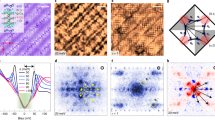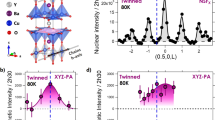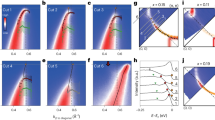Abstract
An outstanding challenge in condensed-matter-physics research over the past three decades has been to understand the pseudogap (PG) phenomenon of the high-transition-temperature (high-Tc) copper oxides. A variety of experiments have indicated a symmetry-broken state below the characteristic temperature T* (refs. 1,2,3,4,5,6,7,8). Among them, although the optical study5 indicated the mesoscopic domains to be small, all these experiments lack nanometre-scale spatial resolution, and the microscopic order parameter has so far remained elusive. Here we report, to our knowledge, the first direct observation of topological spin texture in an underdoped cuprate, YBa2Cu3O6.5, in the PG state, using Lorentz transmission electron microscopy (LTEM). The spin texture features vortex-like magnetization density in the CuO2 sheets, with a relatively large length scale of about 100 nm. We identify the phase-diagram region in which the topological spin texture exists and demonstrate the ortho-II oxygen order and suitable sample thickness to be crucial for its observation by our technique. We also discuss an intriguing interplay observed among the topological spin texture, PG state, charge order and superconductivity.
This is a preview of subscription content, access via your institution
Access options
Access Nature and 54 other Nature Portfolio journals
Get Nature+, our best-value online-access subscription
$29.99 / 30 days
cancel any time
Subscribe to this journal
Receive 51 print issues and online access
$199.00 per year
only $3.90 per issue
Buy this article
- Purchase on Springer Link
- Instant access to full article PDF
Prices may be subject to local taxes which are calculated during checkout




Similar content being viewed by others
Data availability
The data supporting the findings of this study are available within the manuscript and its extended data. Any other relevant data are also available on request from J.Z. Source data are provided with this paper and are available at https://doi.org/10.5281/zenodo.7502830.
References
Sonier, J. E. et al. Anomalous weak magnetism in superconducting YBa2Cu3O6+x. Science 292, 1692–1695 (2001).
Kaminski, A. et al. Spontaneous breaking of time-reversal symmetry in the pseudogap state of a high-Tc superconductor. Nature 416, 610–613 (2002).
Fauqué, B. et al. Magnetic order in the pseudogap phase of high-Tc superconductors. Phys. Rev. Lett. 96, 197001 (2006).
Li, Y. et al. Unusual magnetic order in the pseudogap region of the superconductor HgBa2CuO4+δ. Nature 455, 372–375 (2008).
Zhao, L. et al. A global inversion-symmetry-broken phase inside the pseudogap region of YBa2Cu3Oy. Nat. Phys. 13, 250–254 (2017).
Xia, J. et al. Polar Kerr-effect measurements of the high-temperature YBa2Cu3O6+x superconductor: evidence for broken symmetry near the pseudogap temperature. Phys. Rev Lett 100, 127002 (2008).
Zhang, J. et al. Discovery of slow magnetic fluctuations and critical slowing down in the pseudogap phase of YBa2Cu3Oy. Sci. Adv. 4, eaao5235 (2018).
Mook, H. A. et al. Observation of magnetic order in a superconducting YBa2Cu3O6.6 single crystal using polarized neutron scattering. Phys. Rev. B 78, 020506(R) (2008).
Norman, M. R., Pines, D. & Kallin, C. The pseudogap: friend or foe of high Tc? Adv. Phys. 54, 715–733 (2005).
Shekhter, A. et al. Bounding the pseudogap with a line of phase transitions in YBa2Cu3O6+δ. Nature 498, 75–77 (2013).
Daou, R. et al. Broken rotational symmetry in the pseudogap phase of a high-Tc superconductor. Nature 463, 519–522 (2010).
Sato, Y. et al. Thermodynamic evidence for a nematic phase transition at the onset of the pseudogap in YBa2Cu3Oy. Nat. Phys. 13, 1074–1078 (2017).
Mangin-Thro, L. et al. Intra-unit-cell magnetic correlations near optimal doping in YBa2Cu3O6.85. Nat. Commun. 6, 7705 (2015).
Kapitulnik, K. et al. Polar Kerr effect as probe for time-reversal symmetry breaking in unconventional superconductors. New J. Phys. 11, 055060 (2009).
Lubashevsky, Y. et al. Optical birefringence and dichroism of cuprate superconductors in the THz regime. Phys. Rev. Lett 112, 147001 (2014).
Yu, X. Z. et al. Real-space observation of a two-dimensional skyrmion crystal. Nature 465, 901–904 (2010).
Ishizuka, K. & Allman, B. Phase measurement of atomic resolution image using transport of intensity equation. J. Electron Microsc. 54, 191–197 (2005).
Hücker, M. et al. Competing charge, spin, and superconducting orders in underdoped YBa2Cu3Oy. Phys. Rev. B 90, 054514 (2014).
Blanco-Canosa, S. et al. Resonant X-ray scattering study of charge-density wave correlations in YBa2Cu3O6+x. Phys. Rev. B 90, 054513 (2014).
Grundy, P. J. & Tebble, R. S. Lorentz electron microscopy. Adv. Phys. 17, 153–242 (2006).
Shraiman, B. I. & Siggia, E. D. Mobile vacancies in a quantum Heisenberg antiferromagnet. Phys. Rev. Lett. 61, 467–470 (1988).
Senthil, T. et al. Deconfined quantum critical points. Science 303, 1490–1494 (2004).
Zhang, S.-C. A unified theory based on SO(5) symmetry of superconductivity and antiferromagnetism. Science 275, 1089–1092 (1997).
Varma, C. M. Theory of the pseudogap state of the cuprates. Phys. Rev. B 73, 155113 (2006).
Philippe, B. et al. Loop currents in quantum matter. C. R. Phys. 22, 7–31 (2021).
Bounoua, D. et al. Hidden magnetic texture in the pseudogap phase of high-Tc YBa2Cu3O6.6. Commun. Phys. 5, 268 (2022).
Aji, V. & Varma, C. M. Spin order accompanying loop-current order in cuprate superconductors. Phys. Rev. B 75, 224511 (2007).
Wu, T. et al. 63Cu-NMR study of oxygen disorder in ortho-II YBa2Cu3Oy. Phys. Rev. B 93, 134518 (2016).
Hawthorn, D. G. et al. Resonant elastic soft x-ray scattering in oxygen-ordered YBa2Cu3O6+δ. Phys. Rev. B 84, 075125 (2011).
Chen, C. T. et al. Electronic states in La2−xSrxCuO4+δ probed by soft-x-ray absorption. Phys. Rev. Lett. 66, 104 (1991).
Zeljkovic, I. et al. Imaging the impact of single oxygen atoms on superconducting Bi2+ySr2−yCaCu2O8+x. Science 337, 320–323 (2012).
Baral, P. R. et al. Tuning topological spin textures in size-tailored chiral magnet insulator particles. J. Phys. Chem. C 126, 11855–11866 (2022).
Rybakov, F. N. et al. New type of stable particle-like states in chiral magnets. Phys. Rev. Lett. 115, 117201 (2015).
Zheng, F. S. et al. Experimental observation of chiral magnetic bobbers in B20-type FeGe. Nat. Nanotechnol. 13, 451–455 (2018).
Ghiringhelli, G. et al. Long-range incommensurate charge fluctuations in (Y,Nd)Ba2Cu3O6+x. Science 337, 821–825 (2012).
Chang, J. et al. Direct observation of competition between superconductivity and charge density wave order in YBa2Cu3O6.67. Nat. Phys. 8, 871–876 (2012).
Li, Y. et al. Feedback effect on high-energy magnetic fluctuations in the model high-temperature superconductor HgBa2CuO4+δ observed by electronic Raman scattering. Phys. Rev. Lett. 108, 227003 (2012).
Wang, L. et al. Paramagnons and high-temperature superconductivity in a model family of cuprates. Nat. Commun. 13, 3163 (2022).
Acknowledgements
This work was financially supported by the National Natural Science Foundation of China (Basic Science Center project of NSFC under grant no. 51788104) and supported by the Basic and Applied Basic Research Major Programme of Guangdong Province, China (grant no. 2021B0301030003) and Ji Hua Laboratory (project no. X210141TL210). R.C. thanks the financial support from the National Natural Science Foundation of China (Basic Science Center project of NSFC under grant nos. 51725101, 11727807, 51672050, 61790581 and 22088101) and the Ministry of Science and Technology of China (973 Program project nos. 2021YFA1200600 and 2018YFA0209102). This work partially made use of the resources of the National Center for Electron Microscopy in Beijing. We thank the Thermo Fisher Scientific company for its help in adjusting the electron microscope and providing the liquid helium during our experiment. We thank J. F. Jia for providing the single crystals of YBa2Cu3O6.5. Q. K. Xue is gratefully acknowledged for helpful discussions and assistance.
Author information
Authors and Affiliations
Contributions
J.Z. and Z.W. initiated the idea and designed the studies. Z.W., K.P., L.Y., C.Y., G.C., X.Z., C.W. and Z.L. performed the LTEM experiments, with the help of R.C. Z.W. performed the HAADF-STEM, EELS and electron diffraction experiments and data analysis, with the help of J.Z. All authors contributed to the scientific discussions. Z.W., J.Z., Y.L., R.C. and K.P. wrote the paper, with contributions from all authors.
Corresponding authors
Ethics declarations
Competing interests
The authors declare no competing interests.
Peer review
Peer review information
Nature thanks Fabrizio Carbone and the other, anonymous, reviewer(s) for their contribution to the peer review of this work. Peer reviewer reports are available.
Additional information
Publisher’s note Springer Nature remains neutral with regard to jurisdictional claims in published maps and institutional affiliations.
Extended data figures and tables
Extended Data Fig. 1 Magnetic hysteresis loop of the objective lens in LTEM.
The remanences are shown in the inset image, which is zoomed in on the centre of the figure. As shown, the current of the objective lens could be adjusted between −10% and +40% with a better imaging condition. The loop presents typical soft magnetic properties. The remanences after applying a large magnetic field are about 8.2 mT and −4.1 mT. The degaussed process could further decrease the remanence under 10 mT. We can therefore confirm that such a small remanence will not affect the experimental results.
Extended Data Fig. 2 Evolution of topological spin texture with different magnetic fields (at 300 K) over large areas.
Large-area LTEM images of vortex-like spin textures in YBa2Cu3O6.5 examined in increasing external magnetic fields from top to bottom at a temperature of 300 K. All results are deduced by analysing LTEM images with the TIE.
Extended Data Fig. 3 Evolution of topological spin texture with different magnetic fields (at 10 K) over large areas.
Large-area LTEM images of vortex-like spin textures in YBa2Cu3O6.5 examined in increasing external magnetic fields from top to bottom at a temperature of 10 K. All results are deduced by analysing LTEM images with the TIE.
Extended Data Fig. 4 Evolution of topological spin texture with different temperature fields over large areas.
Large-area LTEM images of topological spin textures in YBa2Cu3O6.5 examined in decreasing external temperature fields from a to j at a zero-field state. All results are deduced by analysing LTEM images with the TIE17.
Extended Data Fig. 5 The relative strength evolution of the topological spin texture with the applied magnetic field and temperature field.
a–j, Magnetic strength images of topological spin textures in YBa2Cu3O6.5 examined in increasing external magnetic fields from left to right at a temperature of 300 K (a–e) and 10 K (f–j). k–t, Magnetic strength images of topological spin texture in YBa2Cu3O6.5 examined in decreasing external temperature fields from left to right at a zero-field state. All magnetic strength mappings are processed under the same condition and the field values are calculated by QPt and digital microscopy software17.
Extended Data Fig. 6 Explanation for the evolution of the relative signal magnitude versus magnetic field and temperature as shown in Fig. 2u,v.
Quantitative analysis of the relative strength evolution of the topological spin texture with the applied magnetic field and temperature field. Although the absolute values of magnetization cannot be determined by LTEM using the TIE method, we are able to show the relative evolutions above. Here we plot the summed and averaged magnitude of each magnetic field mapping, whereas the value observed in a featureless region is defined as ‘zero’. All field mappings are processed under the same condition and the field values are calculated by QPt and digital microscopy software17.
Extended Data Fig. 7 Quantitative chemical mapping analysis of YBa2Cu3O6.0 using super-EDS.
a, HAADF-STEM image indicating the area in which the EDS map is acquired from the red dotted box in g. b–e, Chemical component maps of Y, Ba, Cu and O, respectively. f, Chemical component spectrum over the whole mapping area. g, Electron micrograph of YBa2Cu3O6.0 obtained in the in-focus Fresnel mode of LTEM. The inset shows the corresponding electron diffraction. h, Table showing quantitative analysis of the chemical composition, which is consistent with YBa2Cu3O6.0.
Extended Data Fig. 8 Quantitative chemical mapping analysis of YBa2Cu3O6.5 using super-EDS.
a, HAADF-STEM image indicating the area in which the EDS map is acquired from the red dotted box in g. b–e, Chemical component maps of Y, Ba, Cu and O, respectively. f, Chemical component spectrum over the whole mapping area. g, Electron micrograph of YBa2Cu3O6.5 obtained in the in-focus Fresnel mode of LTEM. The inset shows the corresponding electron diffraction. h, Table showing quantitative analysis of the chemical composition, which is consistent with YBa2Cu3O6.5.
Extended Data Fig. 9 Quantitative chemical mapping analysis of YBa2Cu3O6.9 using super-EDS.
a, HAADF-STEM image indicating the area in which the EDS map is acquired from the red dotted box in g. b–e, Chemical component maps of Y, Ba, Cu and O, respectively. f, Chemical component spectrum over the whole mapping area. g, Electron micrograph of YBa2Cu3O6.9 obtained in the in-focus Fresnel mode of LTEM. The inset shows the corresponding electron diffraction. h, Table showing quantitative analysis of the chemical composition, which is consistent with YBa2Cu3O6.9.
Extended Data Fig. 10 Atomic structure of YBa2Cu3O6.0, YBa2Cu3O6.5 and YBa2Cu3O6.9 along the b axis.
a–c, Atomic structure images of YBa2Cu3O6.0, YBa2Cu3O6.5 and YBa2Cu3O6.9 along the b axis, respectively. The yellow arrows indicate the doped oxygen atoms in Cu–O chain layers of YBa2Cu3O6+x. For YBa2Cu3O6.0, there is no doped oxygen atom in the chain layer. With increasing doping level, the oxygen atoms are injected into the chain layer (as indicated by yellow arrows in b, c) and the chemical composition of the material system is changed from YBa2Cu3O6.0 to YBa2Cu3O6.5 and YBa2Cu3O6.9. These atomic structure images are acquired from each bulk sample with different doping levels. The low-magnification images along the c axis are shown in Fig. 4a–f.
Extended Data Fig. 11 Repetitive LTEM experiments at different labs and with different instruments.
a, Magnetic contrast observation using LTEM mode on an FEI Titan3 Themis G3 60-300 at Fudan University. b, Magnetic contrast observation using LTEM mode on an FEI Titan3 Themis G2 60-300 at Tsinghua University. c, Magnetic contrast observation by using LTEM mode on an FEI Titan 80-300 at Tsinghua University.
Supplementary information
Rights and permissions
Springer Nature or its licensor (e.g. a society or other partner) holds exclusive rights to this article under a publishing agreement with the author(s) or other rightsholder(s); author self-archiving of the accepted manuscript version of this article is solely governed by the terms of such publishing agreement and applicable law.
About this article
Cite this article
Wang, Z., Pei, K., Yang, L. et al. Topological spin texture in the pseudogap phase of a high-Tc superconductor. Nature 615, 405–410 (2023). https://doi.org/10.1038/s41586-023-05731-3
Received:
Accepted:
Published:
Issue Date:
DOI: https://doi.org/10.1038/s41586-023-05731-3
Comments
By submitting a comment you agree to abide by our Terms and Community Guidelines. If you find something abusive or that does not comply with our terms or guidelines please flag it as inappropriate.



